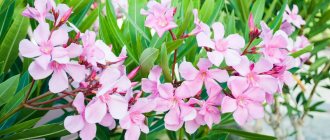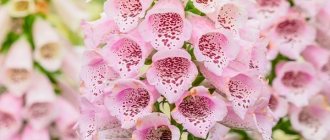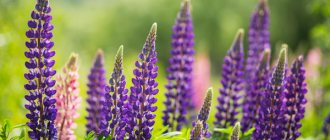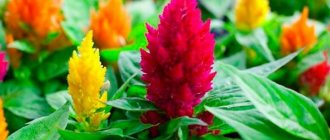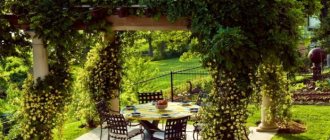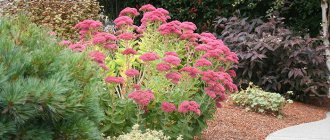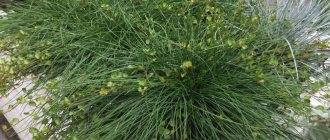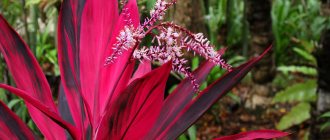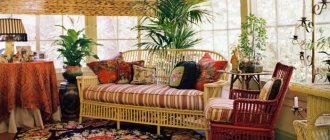Some people cannot tolerate angles in any form.
A good example is the famous round house of Pierre Cardin (Palais Bulles) in the suburbs of Cannes. But we will not delve into the particular worldview of the antagonists of this completely harmless geometric figure, but will do a much more pleasant thing: we will select such highlight plants that will support the “round theme” of the summer cottage. Gomphrena spherical will be harmonious in a round dacha, photo by the author
Why are such plants needed? After all, you can simply arrange round flower beds, place them in the middle of the lawn - and that’s it.
Round flowerbed, photo by the author
This simple win-win solution is quite common in open ground areas. Garden vases of the same shape can also support a round flower bed.
Impatiens in a round garden vase, photo by the author
But what to do when at the dacha every inch of land is worth its weight in gold, and creating a round flower bed is an unaffordable luxury? But I want to round everything off, soften it, make it more comfortable, chamber, intimate...
Leonotis - round beauties for a round dacha, photo by the author
This is where plants come to the rescue. In this area, the undisputed favorites are spherical topiary haircuts of evergreen shrubs, but we will not talk about them. Today we will look at floral perennials and annuals with spherical and hemispherical inflorescences, which during flowering (and often fruiting) will support the round concept of your dacha.
Monarda has hemispherical inflorescences visible after flowering, photo by the author
From a botanical point of view, the concepts of “spherical” and “hemispherical” are very arbitrary, since this can be a head or an umbrella, which, in turn, can be collected into complex whorled inflorescences. In some species, even a basket-shaped inflorescence with a convex hemispherical center of tubular flowers can support a “round” dacha orientation.
Echinacea purpurea with its baskets turns into the prima donna of a flower garden with round shapes, photo by the author
The role of such plants in contrasting compositions cannot be overestimated: thanks to them, shaped harmony in contrast is achieved, flower beds become more interesting.
Ads by
Curly beetle and perennial beetle
Curly beetle (Jasione crispa) and perennial beetle (J. laevis) are amazing (still rare in our dachas) rosette perennial plants from the Campanulaceae family, which in the summer will maintain a cool blue and blue color scheme in the flower garden.
Next to gray stones they will look more natural. Curly beetle, photo from alpine-seeds.com The first comes from Southern Spain, 10 cm high, 15 cm wide, inflorescences up to 2 cm in diameter.
The bukushnik is smooth. Photo from the site mnogoletniki.by
The second is a native of Western and Southern Europe, 20-30 cm high, up to 20 cm wide, inflorescences 2.5-4 cm in diameter.
In English reference literature, their winter temperature minimum is -15ºС, therefore, in central Russia, planting sites must be mulched with an organic substrate and covered with dry leaves on top.
Rudbeckia golden ball in garden design
Rudbeckia dissected is planted in flower beds, the assortment of which does not change from year to year. Its powerful root system is capable of growing quickly, not giving weeds a chance. But this feature is not acceptable everywhere, so to limit the spread of the golden ball, a metal or plastic border dug into the soil is used.
One of the advantages of the golden ball is its habit, which is why the plant is used to camouflage unattractive outbuildings and fences, as well as to create a background for smaller plantings. For example, in a mixborder, gold ball is used in the background or as an intermediate plant between deciduous trees and the main part of the flower garden.
Golden balls look beautiful near any architectural structure for decorative purposes: gazebo, pergola, well. They can also be planted on the porch, near the gate. Solid plantings of the golden ball are grown as a summer hedge for zoning the garden.
Gomphrena globose
The British call Gomphrena globosa globular amaranth, with which it, as a representative of the Amaranthaceae family, is actually related.
Gomphrena globulus, photo by the author In addition to the dwarf (up to 15 cm high) varieties of the 'Buddy' series, the 'Strawberry Fields' variety is interesting, 75-80 cm high, up to 30 cm wide, bright red inflorescences, up to 5 cm in diameter.
Gomphrena globulus 'Buddy White', photo by the author. Gomphrena globulus 'Strawberry Fields'. Photo from freerangestock.com
Also on the website, see the article about this amazing plant:
- Immortal beauty - gomphrena
- Sweet and modest Gomphrena globulus 'Balloons'
Craspedia globulus
Craspedia globosa is an unusual perennial with pompom-shaped yellow inflorescences from the Asteraceae/Compositae family that is grown as an annual.
Craspedia globular. Photo from onlineplantguide.com Craspedia globular is native to distant Australia. It is 60-90 cm high and up to 12 cm wide. Inflorescences appear from August to the end of September on leafless peduncles. Decorative varieties:
- ‘Billy Buttons' – Dutch line;
- 'Drumstick' is an American series.
Craspedia globulus 'Drumstick'. Photo from amazon.co.uk. Craspedia globulus 'Billy Buttons'. Photo from seedempire.comGrown through seedlings. Sow in February, place in a bright place. Planted in open ground in May. Loves fertilizing: 2-3 times with nitrogen and 1 time with a complete complex fertilizer. Used as dried flower.
Tall varieties
Their growing season is short - mid-spring - early summer. On average they grow up to 100-150 cm, sometimes even higher, the diameter of the inflorescences is up to 12 cm. The flowering period is late May-early June. The bulbs are large, so no more than 50 plants are planted per square area.
Aflatunsky (Allium aflatunense)
The species received its name from its natural habitat – the Aflatun Pass in the mountains of Central Asia. The stem is powerful, hollow, from 1 to 1.5 m in height. From one bulb grows up to eight wide, bluish (10-15 cm) leaves.
The first shoots grow through the snow in early spring, fragrant large (up to 12 cm) lilac or purple balls of inflorescences, consisting of star flowers, appear after mid-May. Frost resistance is high - can withstand frosts down to -35 ° C. Hybrids: Gladiator, Mars, Miami, Lucy Ball.
The green leaves and bulbs are edible - the leaves taste like garlic, and the bulbs taste like radish. All parts of the plant have medicinal properties similar to ginseng.
Bulgarian (A. bulgaricum)
One of the most beautiful varieties. At the top of the stem (90-120 cm) a tip is formed (similar in shape to a chili pepper), consisting of the thinnest leaves. When ripe, it unwinds and 20-30 small buds appear on stems. The bud then develops into a bell with pink or burgundy petals edged with white. The flowering period is from May to July.
Giant or gigantic (A. giganteum)
The stems are strong, powerful, and can grow up to 150 cm and higher. The belt-shaped leaf is wide (5-10 cm), smooth, with a bluish tint. The purple inflorescence is multi-flowered, spherical, large (diameter about 15 cm). Flowering period: May-first half of June.
Sicilian or honey garlic (A. siculum)
The species received its name because of its main habitat. The leaf rosette consists of 3-4 narrow (1-2 cm) long (up to 40 cm) smooth leaves. The loose inflorescence in the shape of a bunched umbrella is yellowish-green in the lower part, purple in the upper part. The height of the smooth stem is from 70 to 120 cm.
Onion
Nature generously endowed alliums (Allium), representatives of the Liliaceae family, with spherical and hemispherical umbrellas:
- Maclean's onion (A. macleanii);
- l. highest (A. altissimum);
- l. giant (A. giganteum);
- l. aflatun (A. aflatunense);
- l. round-headed (A. sphaerocephalon);
- l. Karatavi (A. karataviense) and others.
Decorative bows in May, photo by the author Their shape will beautifully emphasize the “round” theme of the dacha, but you just need to choose the right place for planting decorative bows. Many of them come from steppe or mountainous regions with rocky or thin soils. They are accustomed to an abundance of sun and warmth, and to well-permeable soils. Heavy compacted soil that holds water will be detrimental to them.
Planting rudbeckia golden balls
Rudbeckia grows in sunlit or slightly shaded areas. The plant is not picky about the composition of the soil, but before planting, the soil needs to be dug well, weed residues must be removed, and rotted compost must be added to the poor soil. The dug up area is well leveled with a rake, holes are made in the soil at a distance of 40 cm from one another and watered. The seedlings in the box are also watered, the plants with a lump on the roots are removed with a narrow spatula, and one seedling is placed in each hole.
Planting by dividing the bush is carried out in April, when the first shoots appear from the soil. Using a sharp shovel, a part of the root with several sprouts is separated, and together with a lump of earth it is placed in a hole watered with water. The remaining empty space is filled with earth.
Ball-headed Echinops
Echinops sphaerocephalus is another member of the Asteraceae/Compositae family with charming spherical inflorescence heads in blue, light blue and white.
It comes from Central and Southern Europe, the Caucasus, and Siberia. Echinops globulus, photo by the author Its combinations with loosestrife, catnip, foxglove, with the addition of perovskia and gypsophila, provide excellent romantic compositions. Mordovnik is charming in nuanced combinations with falaris, white-flowered aconite and cosmos. Grows best in open areas with alkaline permeable soils.
All of the perennial plants listed above can be found in our catalog, which contains offers from large online stores of seeds and planting material. Choose perennial plants.
Delphinium Crystal fountain, 15 pcs 63 RUR
seedspost.ru
Alpine aster Blue, 0.1 g Alpine slide 32 RUR
seedspost.ru
Amberboa nutmeg Sultan Lilac, 40 pcs. 44 rub.
seedspost.ru
Heuchera Lights of Moscow, Mix, 0.01 g 26 rub.
seedspost.ru
The meaning of gypsophila in a wedding bouquet
Girls often choose gypsophila to decorate a celebration, a bridal bouquet, a hairstyle or a groom's boutonniere. In all cases, the composition looks elegant and delicate.
In addition, gypsophila has another meaning - eternal and bright love. In the Victorian era, it was believed that the flower encourages one to never forget loved ones and always keep warm feelings in the heart. Combined with purity and fortitude, symbolically gypsophila is ideal for a wedding.
To whom and when can you give a bouquet with gypsophila?
Abroad, gypsophila has a second name - “Baby’s Breath”. It is due to the fact that a flower is often given to congratulate on the birth of a baby. When a girl is born, they buy soft pink varieties, and when a boy is born, they buy light blue ones.
A small bouquet of gypsophila can be given to a girl for her birthday or March 8th. Dad will show by example how a real man should behave with a young princess. By the way, you can also surprise your spouse with a mix of gypsophila on International Women’s Day. Such a gift will definitely not seem banal.
Choose red varieties for February 14th or for a declaration of love. This is a great alternative to roses. Like them, the bouquet will tell about love, but not about its sensual and passionate side, but more romantic and spiritual.
If your chosen one has a strong-willed character, she knows how to achieve goals and always goes forward, replace the red gypsophila with purple ones. They are associated with dignity, status and greatness of the recipient. But again, due to the tenderness of the flowers, the gift looks sweet and feminine.
Give yellow, peach, orange and cream flowers to your friends for their birthdays. The shades symbolize joy, warmth, vitality and happiness. And the flowers themselves will emphasize the charm of the birthday girl.
Santolina cypressum
Santolina chamaecyparissus - a luxurious Mediterranean beauty with a height of 50 cm and a width of up to 1 m comes from the Asteraceae / Compositae family.
The bright inflorescences of Santolina behind Erica herbacea attract attention with their beauty, photo by the author. Regular pruning can turn it into a bluish ball, which during the flowering period will be decorated with a mass of yellow spherical inflorescences. For information about the preferences of Santolina, see the article website:
- Silvery herbaceous plants: garden decoration from spring to autumn
- Southern charm of lavender, rosemary and other Mediterranean
Trachymene, or didiscus blue
Trachymene, or blue didiscus (Trachymene caerulea, syn. Didiscus caeruleus) is an interesting annual from the Umbrella family (Apiaceae/Umbelliferae), up to 60 cm high and 23 cm wide. Blue didiscus.
Photo from pbase.com Small lavender-blue flowers with a pleasant subtle aroma are collected in dense spherical umbrellas with a diameter of up to 5 cm. It blooms in open sunny places from late June until late autumn frosts. Seedlings are sown from late March to mid-April. They are planted in open ground at the end of May, when the threat of return frosts has passed, keeping a distance of 20-25 cm between plants.
Cephalophora aromatica
Thanks to its amazing berry aroma, the perennial aromatic cephalophora (Cephalophora aromatica) from the Asteraceae/Compositae family is rapidly gaining popularity. In central Russia it is grown as an annual.
Cephalophora is aromatic. Photo from the website botanichka.ru Not long ago, seeds of the 'Pineapple Dessert' variety appeared on sale. For information on how to grow it, see the commentary on the question:
- How to sow and grow cephalophora correctly?
From time immemorial
There are few plants that people began to cultivate since time immemorial.
Among them are wild onions. They were used for food and to treat diseases back in Ancient Egypt: no less than 4500 years ago. Judging by archaeological finds, the bow played an important role in the life of the Egyptians. It was not without reason that dried arrows and onions were found in sarcophagi next to mummies: the fellow tribesmen of the dead believed that they could not do without them even in the afterlife. Article on the topic Blooming “fern”. Gorse deserves a place in your garden
In ancient times, onions acted both as a food product and as a universal medicine. Numerous methods of its use can be found in the works of Hippocrates and other healers of that time. And the words of Pliny the Elder that the bow “pushes sluggish and elderly people into the arms of Venus” have long become textbook. Many types of onions have a healing effect, in particular, those known under the name wild garlic. bearish and l. victorious, which also look very impressive.
Bows did not lose their positions even in the dark times of the Middle Ages. The most famous healers of that time never tired of praising them, not to mention the fact that they were part of most medicinal recipes. It was then that these plants became “regulars” of apothecary gardens, which, in turn, served as the prototype of modern decorative flower beds. After all, onions are not only remarkable for their beneficial properties, but also extremely beautiful. Moreover, this was noticed centuries ago, when purple giant onions began to be used in ornamental gardens.
By the way
Onions are undemanding to growing conditions. They need open, bright, well-warmed places and love light, drained, but well-moistened soil, with acidity close to neutral. In addition, they require minimal care, which allows them to be successfully grown even by weekend gardeners.
Photo: From personal archive/Andrey Lysikov
